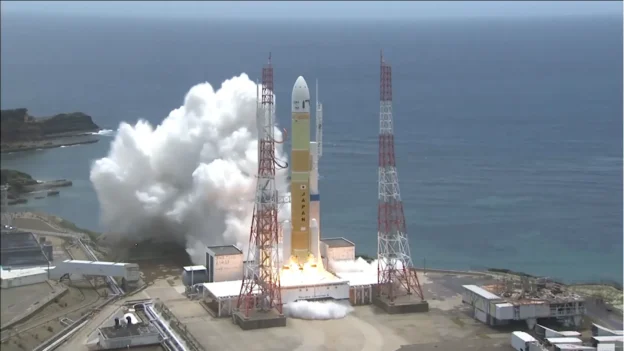Japan has successfully launched its new H3 rocket, carrying an Earth observation satellite from a space center on a southwestern island. This launch represents an important boost for the country’s future space projects.
The launch of the H3 rocket
The H3 No. 3 rocket was built in Japan and prepared for liftoff, which began precisely at 12:06 p.m. from the Tanegashima Space Center in Kagoshima Prefecture. After the flight, 5 minutes later, the first stage of the launch was completed. Subsequently, the satellite separated from the rocket 16 minutes later, reaching an altitude of 613 kilometers.
The Advanced Earth Observing Satellite-4, also known as Daichi-4, succeeded in sending its signal to Santiago Station in Chile at 12:59 pm. The Japan Aerospace Exploration Agency confirmed that the satellite’s Solar Acquisition Mode was working properly.
According to Makoto Arita, project manager, the launch was a complete success.“We are relieved by the second consecutive success of the H3,” Arita said at a press conference. This launch of the H3, successor to the H2A vehicle, takes place in a context where Japan is seeking to consolidate its position in the competitive satellite launch sector, with the intention of carrying out six launches per year.
H3 rocket tests
Initially, the launch of H3 No. 3 was scheduled for Sunday, but was postponed due to bad weather conditions. In March 2023, the first launch of H3 No. 1 failed when it was ordered to self-destruct due to a second stage engine ignition failure. However, the launch of H3 No. 2 in February was successful.
The satellite carried by H3 No. 3 is intended to observe areas affected by disasters and to monitor changes in the terrain caused by volcanic activity or earthquakes. However, the use of radar technology allows the satellite to take images even in adverse weather conditions and at night, which will allow early detection of unusual changes in volcanic activity, land subsidence and landslides.
This space vehicle is developed by JAXA and Mitsubishi Heavy Industries, with a liquid-fueled structure, designed to be the next heavy-lift launch rocket from Japan. launch rocket. According to JAXA, the cost of the H3 launch service is expected to be lower than that of the H2A.

The launch of the third “H3” vehicle with the Daichi 4 satellite on board. Source: JAXA
The H2A will end operations in FY 2024 with the launch of the No. 50 rocket, and the H3 is expected to fully assume this role in FY 2025. In addition, the H3 will play a key role in the U.S.-led Artemis lunar exploration program, in which Japanese astronauts are planned to be sent to the Moon along with U.S. astronauts, as well as in the exploration of Martian moons to retrieve samples.
Follow us on social networks and don’t miss any of our publications!
YouTube LinkedIn Facebook Instagram X
Source and photo: JAXA

